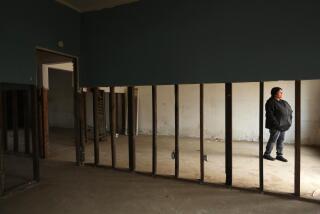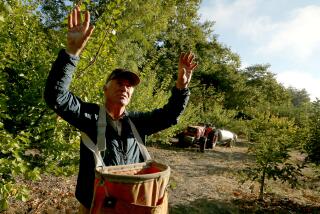The Ripple Effect of Dry Times : Agriculture: In the Fresno County community of Firebaugh, the drought has eaten away at the townâs economic roots.
FIREBAUGH, Calif. â In California cities, it is called the âMarch Miracle,â a monthlong storm system that could ring the death knell for tough urban water-rationing programs. But on the west side of Fresno County, the impact of the drought goes on.
Regardless of the recent rains, Domenic Enrico will idle 1,600 acres of prime agricultural land this planting season, growing weeds on more acres than heâs planting cotton, tomatoes, or any other crop that would bring in money and pay off bills.
Heâll still lay off 15 workers and still be $110,000 in the red come yearâs end. But worse than that, his problem will contribute to the economic downfall of Firebaugh, a half-square-mile strip of farm-dependent city stretched along Highway 33 in the heart of the Central Valley.
When Enrico doesnât plant cotton--and heâs down 800 acres this season--he doesnât buy cotton seed or get his crop processed at Broadview Cooperative Gin. Broadviewâs now in bad shape, with layoffs planned and equipment repairs deferred.
When Enrico Farms doesnât buy tractors, businesses such as Firebaugh Equipment feel the pinch. At Firebaugh Equipment, the repair staff is on shortened work weeks because sales and maintenance orders have dropped.
Four years of drought have done more than just devastate Firebaughâs farms, though they took the first hit hard and early. In this agricultural company town, when crops donât get planted because of a lack of water, migrant workers stay away. Sales fall, school enrollment drops, city services are endangered.
This tiny farm town west of Fresno is choking on the dust of natural disaster, both freeze and drought. The month of rain has not reversed the damage and has even caused some of its own. Firebaughâs fall from prosperity marks a steady descent that has left few businesses untouched.
âThese rains will help, but theyâre not what we need yet,â said Dean Lawley, a labor contractor whose business was cut severely by the drought and is now completely idled because the untimely rain keeps his few remaining workers out of the fields. âThereâs still a drought. Just because itâs muddy today, donât mean thereâll be water three months down the line.â
O and P streets make up Firebaughâs central business district, an increasingly quiet stretch where the words âClearance Saleâ have lost their draw, where âClosedâ and âFor Leaseâ are more common and more eloquent. Small businesses have shortened their hours a little more each year. Idle clerks stare out of aging storefronts at the empty street, waiting for an erstwhile customer.
Jim Lowe, manager of B&B; Liquor and Video on O Street, said he noticed a drop in his business more than two years ago. He blames the earliest slowdown on immigration amnesty, which gave many workers legal residency status and allowed them to move on to other areas and better job opportunities.
Now he blames the drought.
âI used to stay open till 11 p.m., but two to three years ago, anything after 10 p.m. was a dog,â said Lowe, who is closing the store earlier each year. âThis year, itâs anything after 9 p.m.â
Jack DuBeau, owner of the recently opened Champion Chevrolet car dealership just off Highway 33, says 95% of his sales are to farmers and farm workers. Not surprisingly, he has had to revise his business plan downward several times since he opened the business last year.
April Foolâs Day was Championâs grand opening, and DuBeau figured at the time that if he sold at least 20 new cars each month, he could pay his bills and start building his future. By fall, he was shooting for 15 new-car sales each month to stay alive.
Reality hit hard in January, when DuBeau sold eight or nine new vehicles that month. Not only have new customers stopped buying, but many who ordered vehicles in the fall for spring delivery have canceled their orders.
âWe can get by this year, but itâll be very, very, very tough,â DuBeau said as he sat in his empty showroom. âBut if we donât get (enough) rain this year, itâll be goodby. Every farm town in this valleyâs going to shrivel up and die.â
Firebaugh is western Fresno Countyâs farming and farm equipment hub. It is the nationâs cantaloupe capital and a prime growing area for cotton, canning tomatoes and livestock--when thereâs enough water. Right now there isnât.
âItâs probable this year that weâll see a decrease in cotton acreage,â said L. V. Hawley, supervising agricultural standards specialist for the Fresno County Department of Agriculture. âThereâs probably going to be a whole lot less wheat, barley and oats. I expect to see alfalfa hay and seed alfalfa abandoned.â
In the Westlands Water District, the water source for many of Firebaughâs farms, an estimated 518,000 acres are generally irrigated and planted. District officials predict that 170,000 acres will lie fallow this year because of the drought, and crop loss alone should hit $200 million.
âThe drought is still on,â said Rob Leake, spokesman for Westlands. âThis storm has actually gummed things up instead of helping. Tomatoes have been flooded out. Cotton has not been planted yet. Everythingâs the same; now farmers have had to deal with some flooding and some hail.â
Fallow land means less work. And when there is less work in Firebaugh, the laborers who travel from other parts of California and from Mexico for employment stay away. Those who are left have little disposable income, forcing local businesses to tighten their belts.
Dean Lawley supplies farm workers for much of the Central Valley. At this time of year, planting season, he usually has a crew of 200 to 300 workers. Several weeks ago, he was supervising 40 to 50. Now the rains have kept even those workers from the fields.
At peak harvest time, he usually has 1,500 to 1,600 workers picking area produce; this year the number will be drastically reduced. For 1990, he mailed out 5,000 W-2 forms; for 1991, he expects to send out one-third that number.
âI have one man who does all my hiring,â Lawley said as he sipped coffee at Three Rocks Cafe south of Firebaugh. âHeâs getting phone calls all day and all night from people wanting to go to work. Thereâs nothing for them to do.â
The families who have stayed away are affecting the areaâs schools. Firebaugh-Los Deltas Unified School District usually sees fall enrollment of students dip a bit at Christmas as some families leave the area for holidays in Mexico. By now, however, enrollment would have returned to its fall level and start to climb, as workers arrive for spring planting.
âBut now weâre down about 45 kids, and weâre not seeing the growth that we usually see as the migrant workers come percolating back,â Supt. Bruce Griffith said. âWeâre not anticipating any growth for next year.â
And the worst is yet to come.
The federal government announced in February that water deliveries from the Central Valley Project to the stateâs farmers would be cut by 75%. Although there are some wells in the area, most Firebaugh farmers rely heavily on federal water. While the rains have helped fill reservoirs throughout the state, so far there are plans only to increase water allotments to cities, not agriculture.
Unemployment, which is normally around 30% in the Firebaugh area, is expected to rise as water cutbacks begin to affect spring planting. Steve Sutter, a farm adviser with the University of California Cooperative Extension in Fresno, predicts that the drought in the San Joaquin Valley could cost between 50,000 and 60,000 workers their jobs.
Total agriculture industry wages and salaries--which usually hit $1.7 billion in the San Joaquin Valley--could drop by as much as $500 million.
Many predict that Year Five of the drought still could be painful, and agriculture throughout the state could still suffer. Farmers here began to feel the pinch more than a year earlier than many of their counterparts in other areas.
There has already been a dramatic drop in the number of cattle grazed in the Firebaugh area. The drought dried up all natural drinking water supplies, and forage for grazing animals has disappeared. The rains have helped replenish these supplies, but they came at the tail end of the November-to-May cattle season and will do little good.
Four years ago, when what would be the worst drought of the century began, cattleman Phil Martin stopped buying replacements and breeders to replenish his 1,700-head herd.
Since that time, his herd has dwindled to about 700, and he has sold off 10,000 of the 70,000 acres he owned and leased. He has taken cattle to New Mexico to graze and has laid off two of his three ranch hands.
A month ago, Martin feared that he would have to sell off his remaining herd, but the rains have increased forage and he will now be able to keep them. Still, the rains came too late for him to keep the money-making part of his business--stocker cattle that he buys in the fall, fattens up and then sells in spring.
âI should have run an additional 4,000 head of stocker cattle plus those 700 cows,â Martin said. âThe stocker would have probably grossed me $200,000. I didnât get to do that. My cash flow is about 50% of what it should be.â
Last year, Rod Cardella called the well drillers for the first time since the drought of 1977. Cardella Ranch drilled three wells during that last dry time and hasnât used them since. But in 1990, Cardella spent $95,000 to get the wells up and running again.
He also stopped planting cotton on his 2,100-acre ranch in 1990 because cotton is one of the thirstier crops grown in the Firebaugh area. There will be no cotton in 1991, either, along with fewer tomatoes and onions.
With 75% less water this year, Cardella will plant only one-third of his land. Heâll hire 65 fewer workers and wonât buy the $180,000 tomato picker and the two pickup trucks heâd planned earlier. Even with such stringent economizing, he expects to be $250,000 in the red.
Being a farmer is a lot like being a boxer, he says as he navigates his pickup through narrow country lanes that border his ranch.
âYou work your butt off 10 months a year and have a good round and feel great,â Cardella said. âThen you go and get (flattened) and have to go back to the ring bleeding. You feel like throwing in the towel. And what theyâre throwing at me this year are some punches Iâve never seen.â
Travel north on Highway 33 from the Cardella land and you canât miss the huge white structure that houses the N. F. Davis Drier & Elevator, where in good times as many as 37,500 tons of locally grown rice are processed and stored each year.
The last good year was 1987. By 1990, the company was drying 5,000 tons; this year the elevator will stand empty, says company president and local farmer Narval Davis. Thatâs a problem for Davis, who will also grow no rice this year. Many legislators and urban dwellers, on the other hand, point to rice farming as a waste of water.
Not only will Davis idle half of his land--he farms more than 1,000 acres of cotton, wheat, tomatoes, onions and other crops--but he is starting the paperwork to shorten his 23-person staffâs work week by two to three days and have unemployment insurance fill in the gap.
At Enrico Farms, Domenic Enrico had planned to grow 750 acres of canning tomatoes; only 450 acres will actually get planted. Instead of 1,600 acres of cotton, heâll plant 800. What that means is a $110,000 loss, 15 layoffs and a lot less money spent in town. With decisions such as Enricoâs percolating through Firebaughâs farms, the town stands to lose as big as the farmers.
âI would have bought some wheel tractors, $40,000 to $50,000 each,â Enrico said. âWeâve got 15 that need replacing. I would have bought a vineyard tractor. Thatâs $32,500. . . . Weâre going to be putting off buying anything for a few years.â
Leaders of cotton and rice organizations predict acreage drops of about 30% statewide as farmers such as Davis, Cardella and Enrico cut back because of the drought. The cutbacks most likely will bring price hikes and assuage some--but not all--of the droughtâs effects.
Outside of the stateâs rice and cotton belts, there is little sympathy for such growers because their crops use too much precious water and are often in surplus. But here in Firebaugh, the growersâ pain is the cityâs pain. And local business owners are acutely aware of growersâ tight holds on their wallets.
March is cotton-planting time, and at Broadview Cooperative Gin, where Enrico buys his seed and sends his cotton for processing, manager Kenneth Rowan sees serious trouble.
In 1990, federal water had been cut back by 50%, but the drought and subsequent overuse by farmers had not yet depleted the areaâs ground water. As a result, his growers produced 43,000 bales of cotton, down from the norm of 50,000 bales.
This year, that already reduced number will be cut to 25,000 bales. Rowan has sold enough cotton seed for growers to plant 7,800 acres, down from last yearâs 13,635 acres.
âOur business will be down almost half,â Rowan said. âInstead of operating October, November and the biggest part of December, weâll be operating October and half of November. Instead of keeping our labor on three months, weâll keep it on half. Weâll only use half the propane. Weâll be using half the tires and half the fuel, right on down the line. Itâll have a tremendous ripple effect.â
Enrico buys some of his machinery at Firebaugh Equipment, the areaâs Case International tractor dealership. Sales manager Jon West reports that sales are down and that growers are reluctant to make any long-term financial commitments.
Robert Gomez, manager of Firebaughâs Coronet Variety Store, recently cut his entire staff from 40 hours of work each week to 25.
On a recent Thursday afternoon, there was only one customer in the establishment, a shopper buying one small bag of jelly beans. Then the woman from the Employment Development Department strolled in to talk to Gomez.
Their conversation was painfully short: She wanted Gomez to hire unemployed workers from the stream that courses through her office each day. Gomez said no.
âI can see the drought in my sales,â Gomez said. âTheyâve dropped 10% to 15% compared to last year. Thereâs not a lot of work in Firebaugh right now, and in the summer itâs going to be real sluggish.â
ECONOMICS OF DROUGHT AND DISASTER Fresno County, with Firebaugh at the hub, is the No. 1 farm county in the nation in terms of gross farm revenue; many say itâs the top agricultural county in the world. But drier times, coming on the heels of one of the worst freezes in California history, compounded Fresno Countyâs losses for 1991. In this microcosm of California agriculture, farm revenue in 1991 could be down as much as 25% from a year ago.
FRESNO COUNTY FARM REVENUE Revenue in billions
FRESNO COUNTY CROP DAMAGE The drought and the freeze will take a toll on Fresno County agriculture in 1991. The county figures that it suffered about $90.6 million in crop losses during the freeze alone.Losses in millions CITRUS LOSS WAS $79.4 MILLION DOLLARS Source: Fresno County Department of Agriculture
More to Read
Sign up for Essential California
The most important California stories and recommendations in your inbox every morning.
You may occasionally receive promotional content from the Los Angeles Times.











